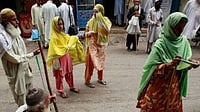- The fiscal deficit (new debt) is growing steadily and fast. Only two countries—Albania and Lebanon—have worse figures, and two more—Mongolia and Zimbabwe—as bad, says the latest imf study on India. In 1995-96, the consolidated fiscal deficit (CFD) of the Centre and states was 6.5 per cent of the GDP. It's now 10.5 per cent despite the government's claimed efforts to contain it. If we add just the power sector losses, it rises to 12 per cent.
- This CFD doesn't include the contingent liabilities which includes government guarantees, pensions, etc. Acharya says that these "are not counted until they become actual liabilities. But, as recent events in the financial sector have shown, undefined commitments of government support to financial institutions can quickly translate into sizeable actual claims on the budget." So, the various bailout schemes for state-owned financial institutions like UTI, IFCI and IDBI and extra-budgetary provisions like the oil pool deficit are not only a part of the total public debt but also a potential claim on the CFD. Combined government guarantees stand at 12 per cent of GDP and rising as states increasingly opt for innovative borrowings and special purpose vehicles. Naturally, some of them have begun to defer debt service. Beginning with Rs 1,789 crore just this fiscal, states have to repay a whopping Rs 103,775 crore till 2011-12!
- The consolidated revenue deficit is now over 50 per cent higher than the pre-crisis level and the primary deficit (the difference between all government spending except interest outgo and its earnings) more than doubled since 1997-98. According to an Amex study, 'Economics for Investment', we have the highest primary deficit of 20 biggest emerging economies! Why is this alarming? Because at both the Centre and the states, more in the states, the fiscal problem is essentially a revenue account problem, caused by both declining revenues and rising expenses—salaries, pensions and other costs of just running a government. Over 1990-2001, the only reduction in CFD happened (in '96-97) due to reduction in development spending. So, the way debt is used also determines its sustainability and our way isn't right.
- Revenue account is a mess in all states. Non-developmental expenditure in states was 6 per cent of GDP in 2000-01, and interest payments took one third of that. States have been taking the easy way out by crying off to the Centre. Thus, in 2000-01, while gross devolutions and transfer from the Centre rose 28 per cent, the net figure rose higher at 40 per cent. Why? Because repayments have been dwindling. The Centre went strict some years ago but things are better with "bailout" Jaswant Singh. States have been allowed debt swaps of Rs 25,000 crore every year for the next five years and five on-brink states have got five-year loans.
The Silent Debt Wish
As the reforms rabbit turns turtle, a severe internal debt trap is bogging India down More Coverage

The Silent Debt Wish
The Silent Debt Wish
Published At:
MOST POPULAR
WATCH
MORE FROM THE AUTHOR
×

















_.jpg?w=200&auto=format%2Ccompress&fit=max)



